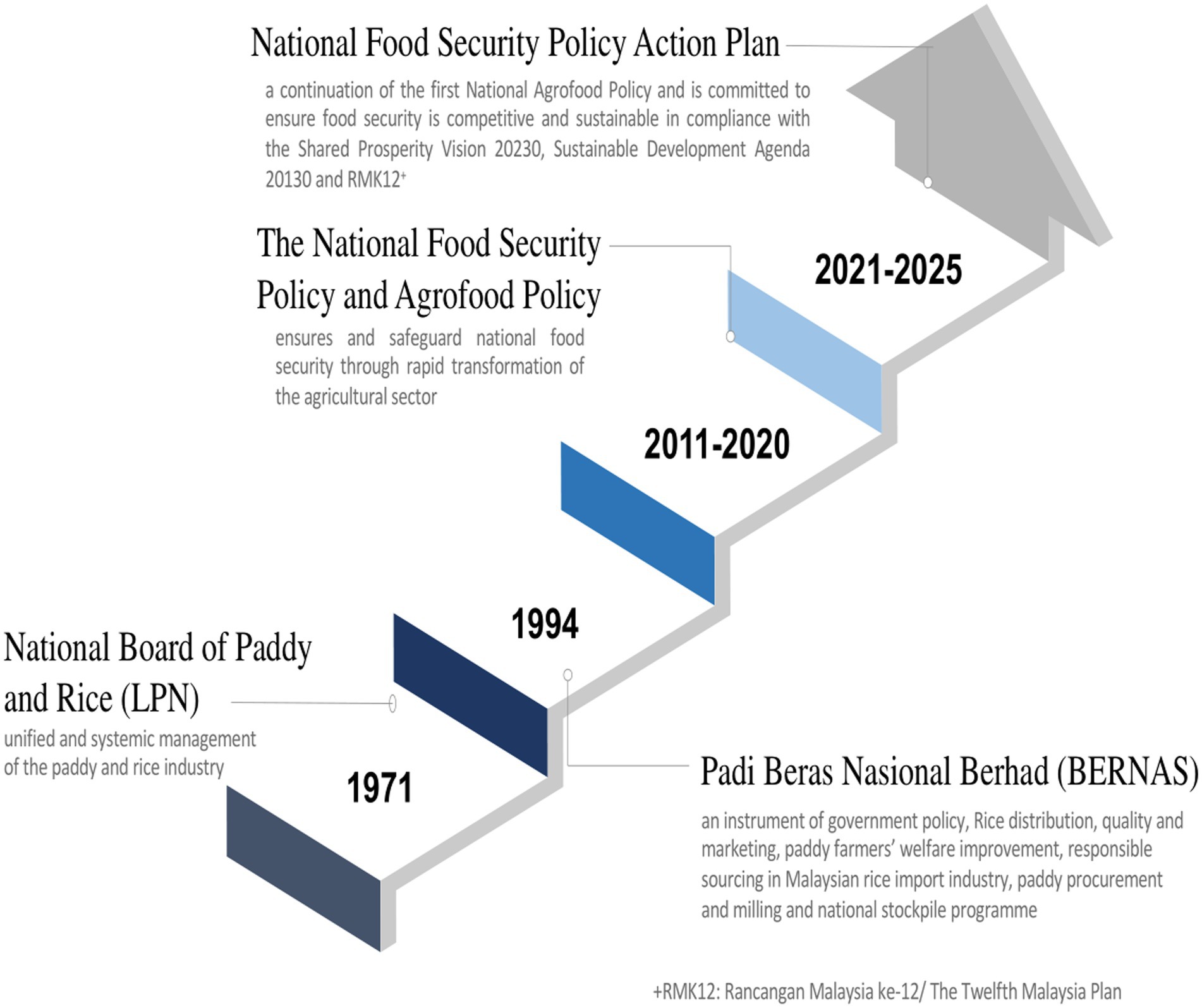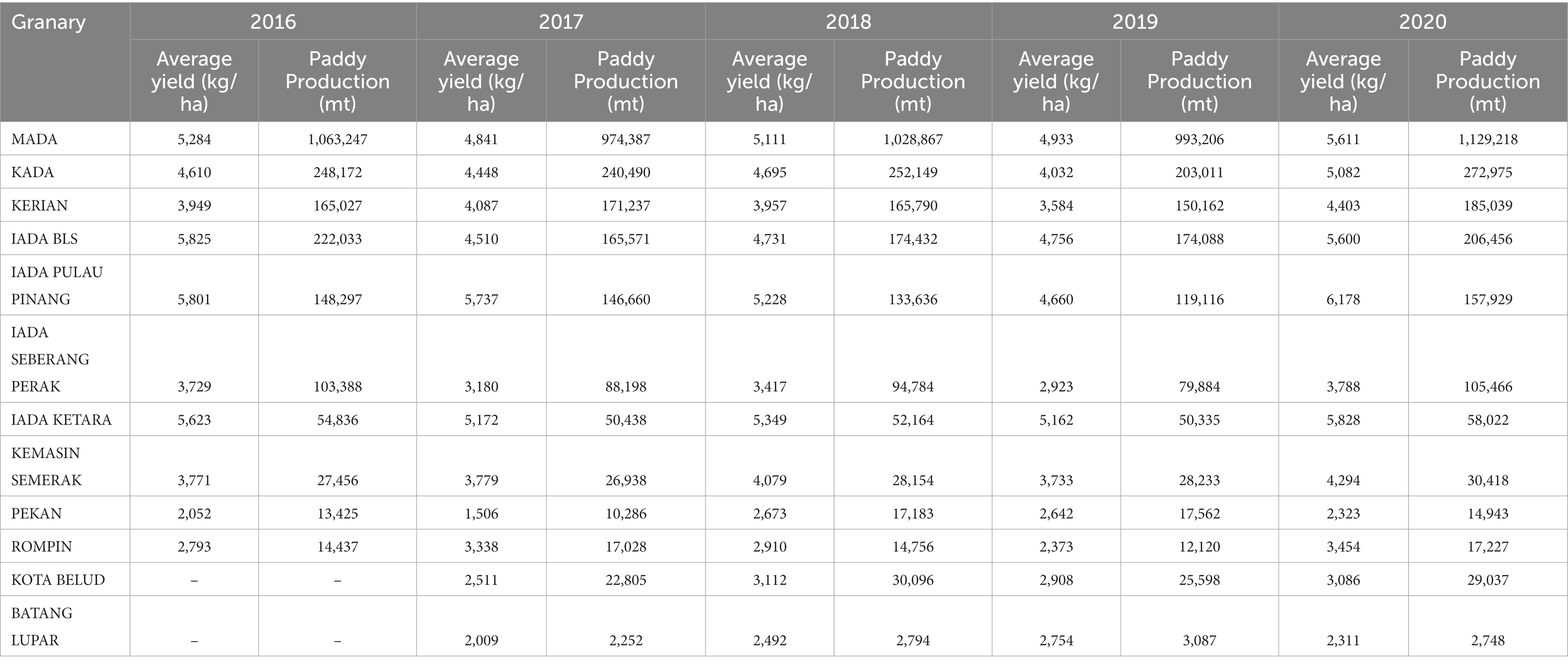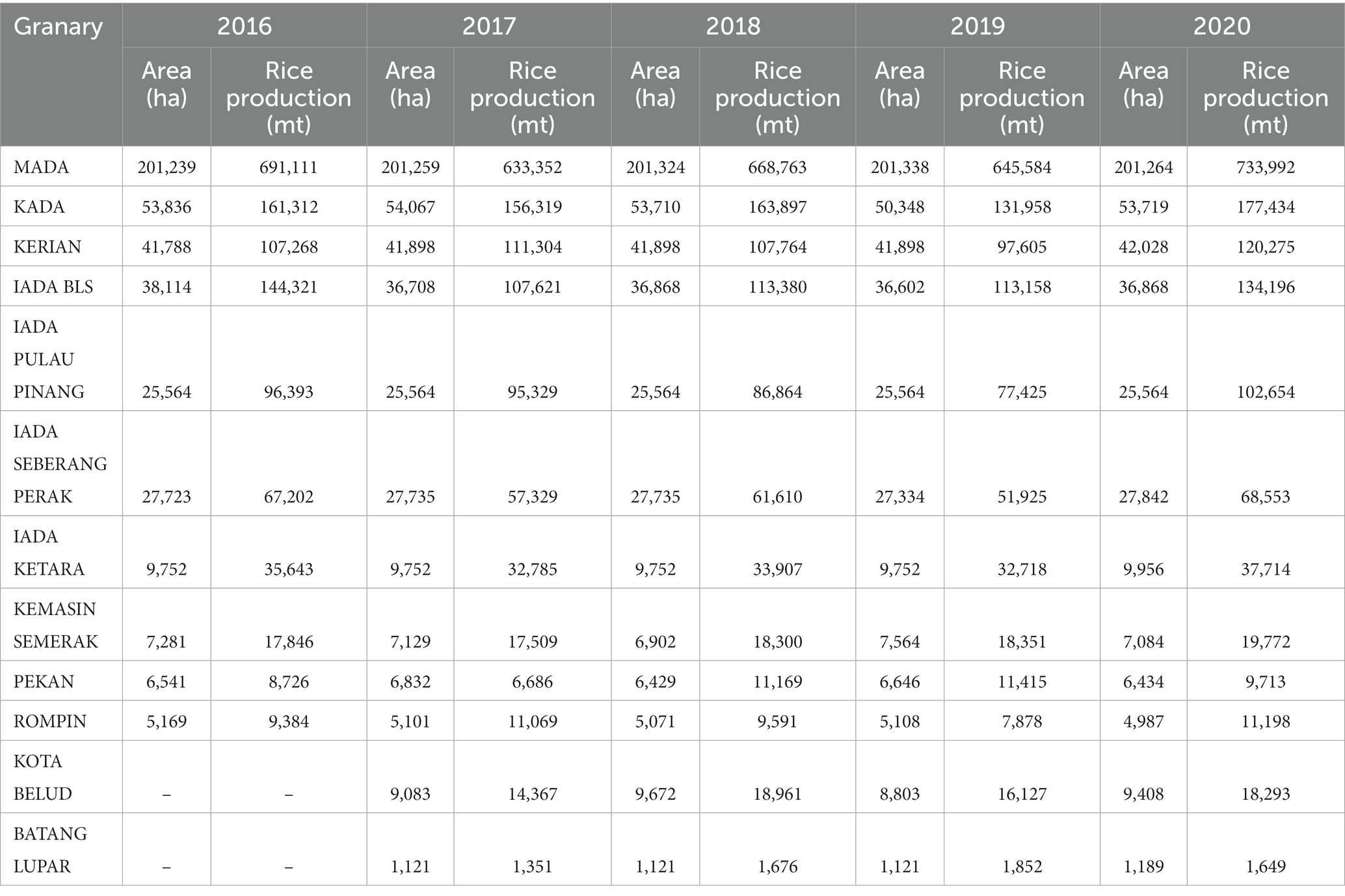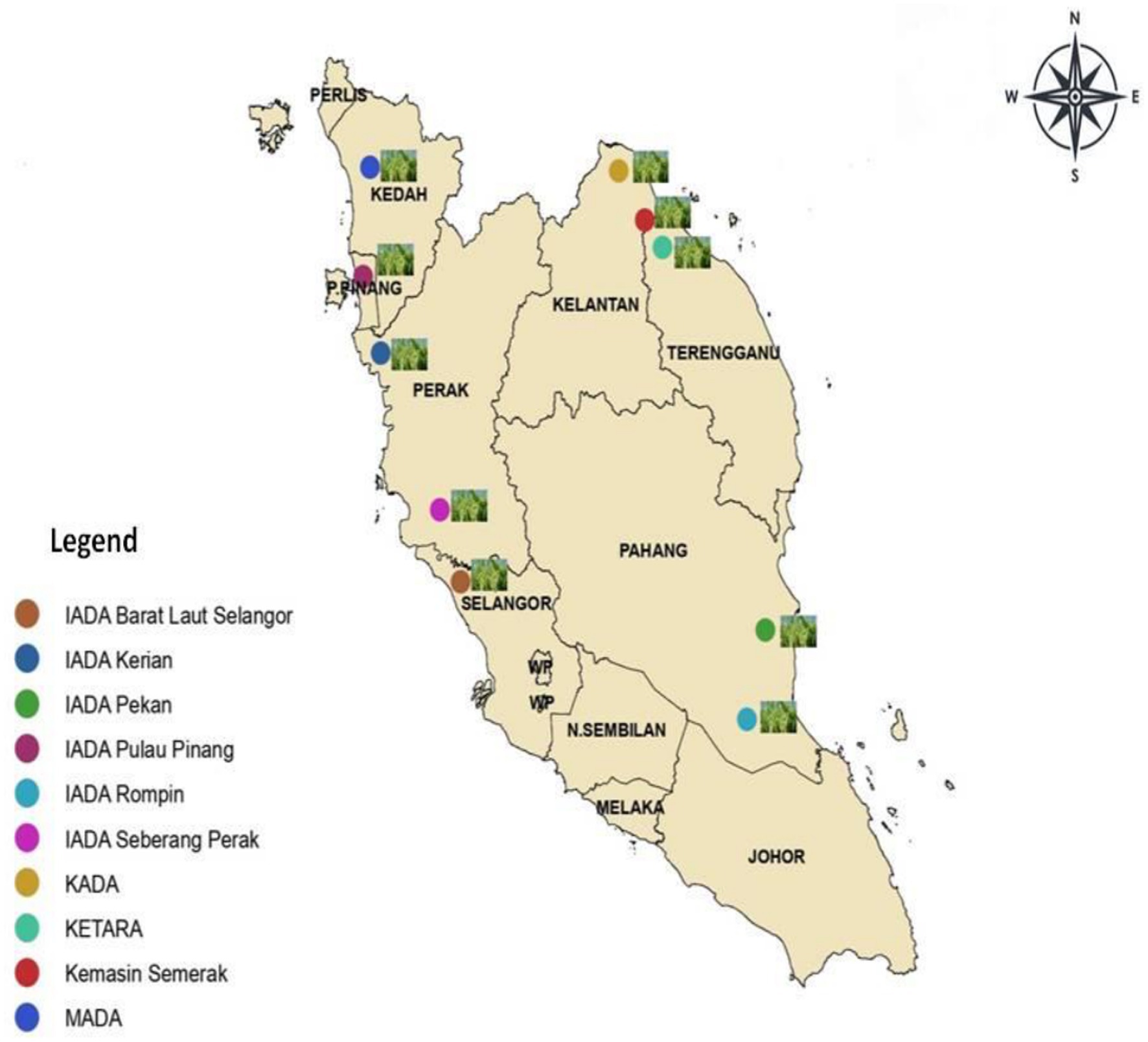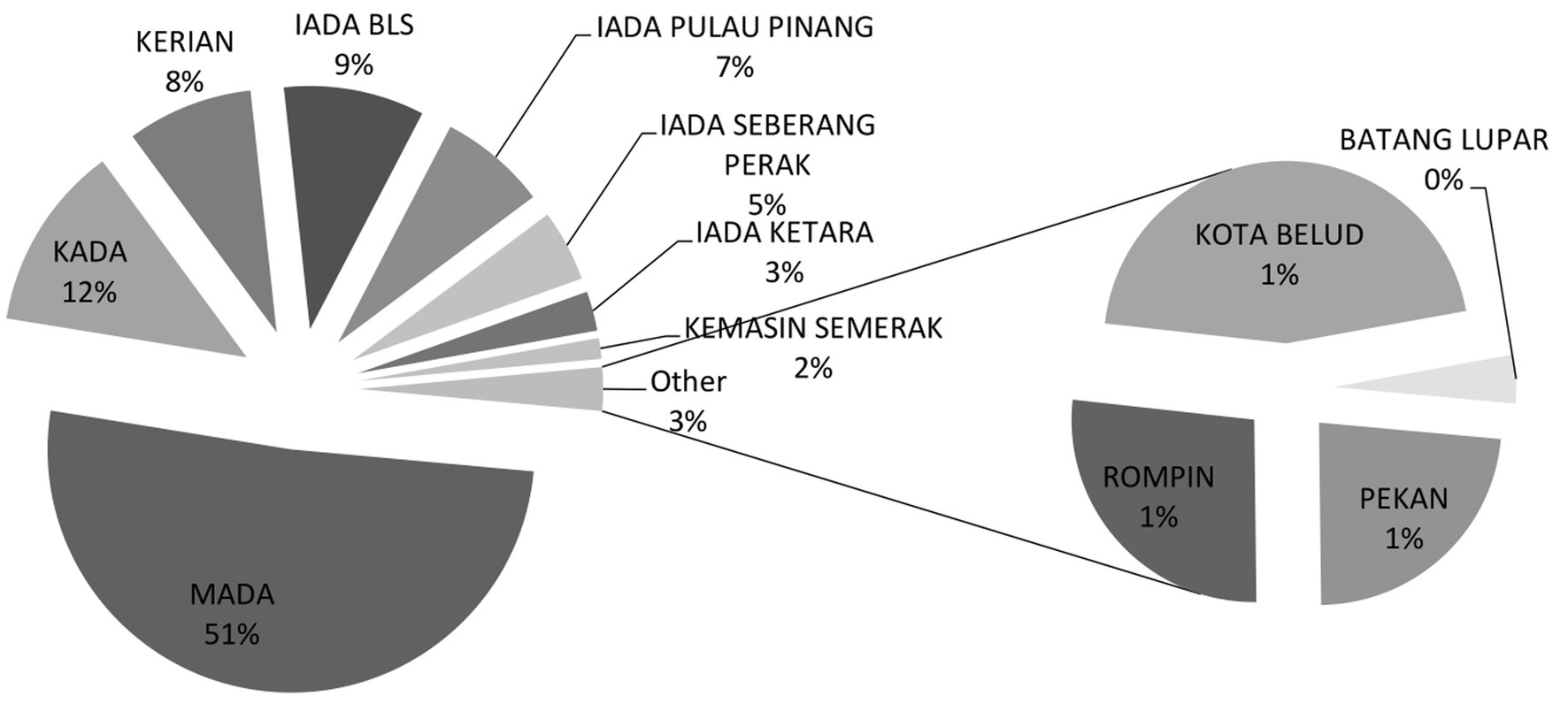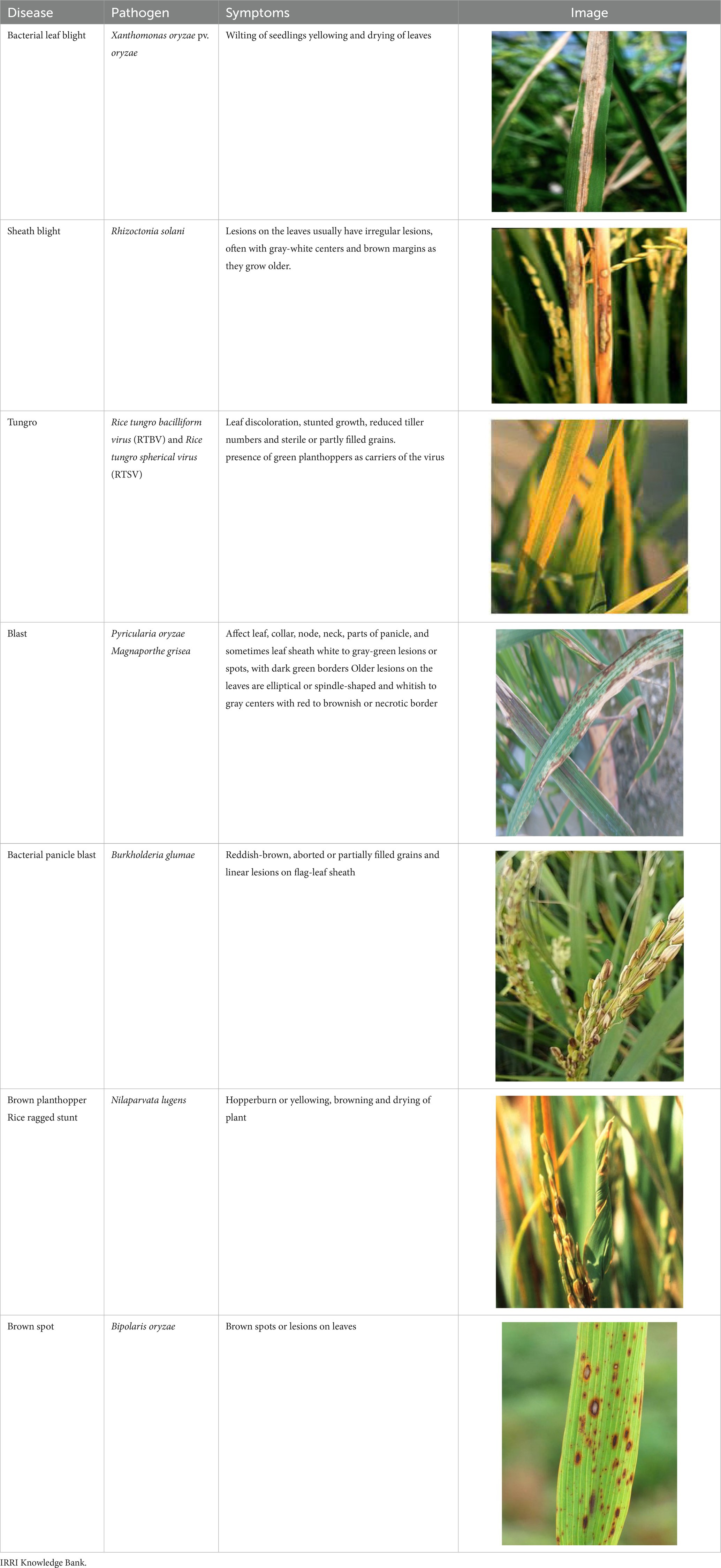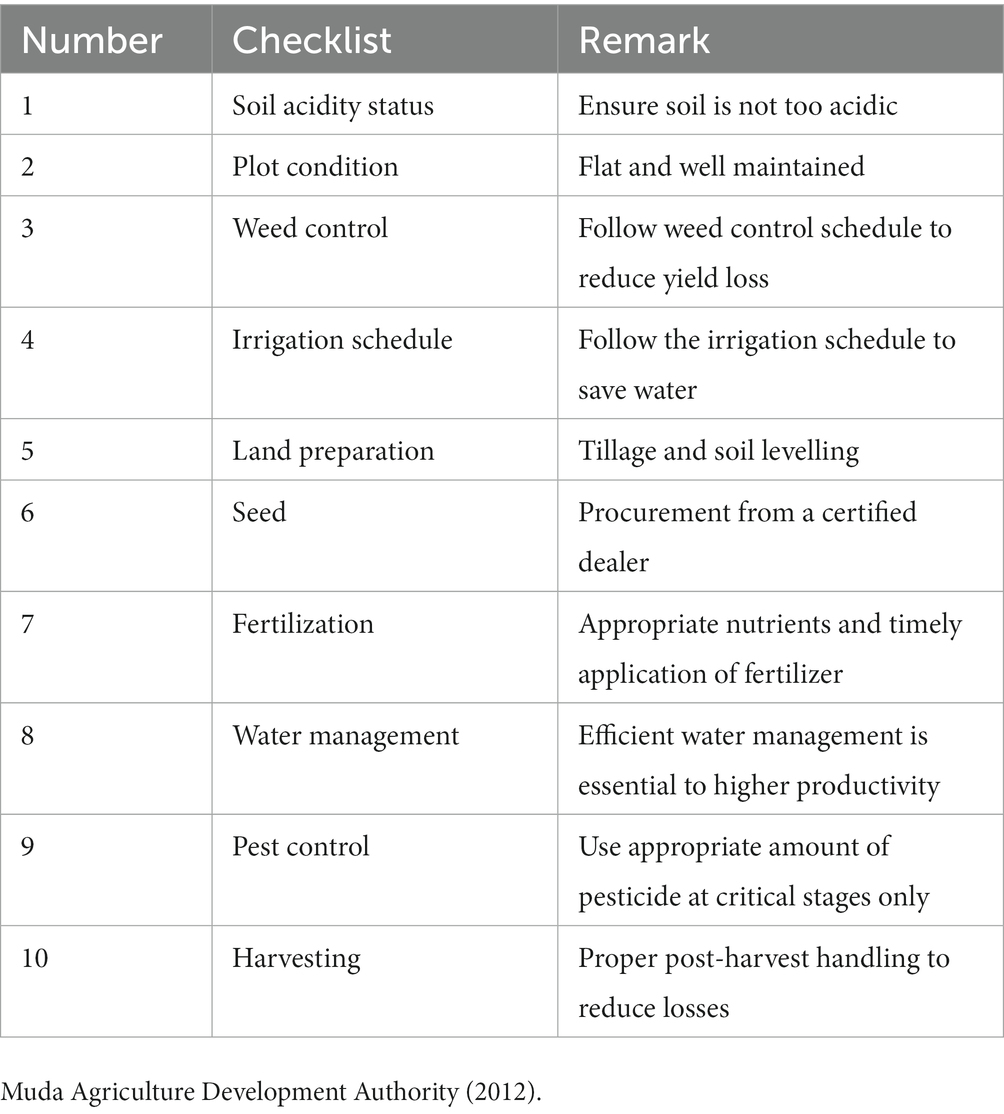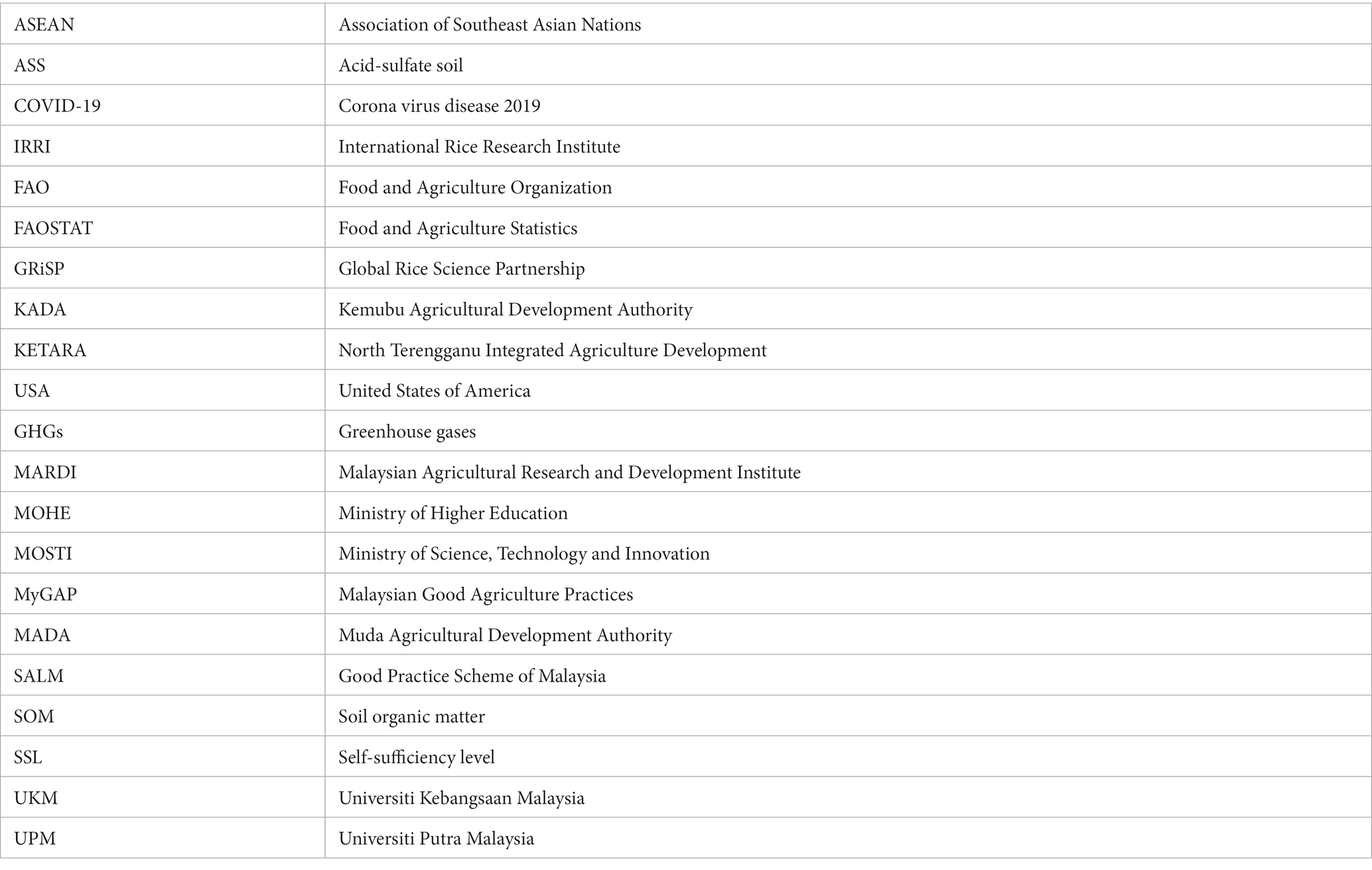- 1Institute for Environment and Development (LESTARI), Universiti Kebangsaan Malaysia, Bangi, Selangor, Malaysia
- 2Institute of Systems Biology (INBIOSIS), Universiti Kebangsaan Malaysia, Bangi, Selangor, Malaysia
Rice is an important staple food for nearly half the world’s population. In Malaysia, rice and paddy cultivation kickstarted in the early 60s with small-scale farming, which later expanded by leaps and bounds before emerging as the country’s utmost important food crop. Over the decades, Malaysian rice production system has been suffering from various challenges which include extreme weather conditions, poor soil fertility and nutrient management, farmers’ lack of awareness and knowledge, hesitancy against genetically-modified planting materials and poor deployment of technology. The national rice production and consumption, simply measured as self-sufficiency status staggers in between 67 and 70%. The Southeast Asia region has been an important rice export trader with Thailand, Vietnam and Cambodia, among the biggest rice-producing nations. Food security, under the context of sustaining international rice trading ties, succumbs to functional fluctuations of global supply chains. During the unprecedented COVID-19 pandemic, the containment period during the outbreak led to significant disruptions to the food production chain. During the early phase of the pandemic, Malaysia experienced a volatile rice import trend, facing difficulty to secure a committed rice trading partner. In this review, we discuss the trajectory of the rice and paddy industry in Malaysia since its inception, lab-to-field translated breeding strategies adopted for rice yield improvement, governmental participation and contribution (approaches, policies and programs) and technologies in use for rice production. Further, relevant cutting-edge technologies, agricultural methods and practices catered for modern Malaysian rice farming, with opportunities to improve and enhance crop health and resilience are included. The review findings inform new rice agricultural practices, suggest research directions toward sustainable rice farming and provide a comprehensive knowledge base to accelerate innovation, technology diffusion and technology adoption for a resilient rice production system in Malaysia.
Introduction
According to IRRI (1995), more than a billion people around the world rely on rice cultivation for subsistence and livelihood. In developing countries, rice farming is the main source of income for about 200 million households (FAO, 2004) (Figure 1). Feeding more than 3.5 billion people, rice is the second most important food crop as it is relatively cheap, nutritious and fulfils the average calorie requirement of an individual (IRRI, 2010). Besides, rice provides a significant portion of dietary protein for about 520 million people living in poverty in Asia (Muthayya et al., 2014). Globally, rice is grown in over 100 countries encompassing about 162.06 million hectares with an annual production of 495.78 million tonnes of milled rice (715 million tons of paddy rice) (FAOSTAT, 2020; Figures 2, 3). In Asia and sub-Saharan Africa, rice is mostly grown on small farms stretching between 0.5 and 3 ha while in others such as Australia, the USA and South American countries, the farms are much larger, at about 2–3 thousand acres (Rao et al., 2017). It is estimated that rice production must increase by 114 million tons by 2035 in parallel with the expected population growth (Suzanne et al., 2012). Under this context, rice production intensification with minimal impact on natural resources and the engaging agro-systems sets a challenging call for food security (Ladha et al., 2015).
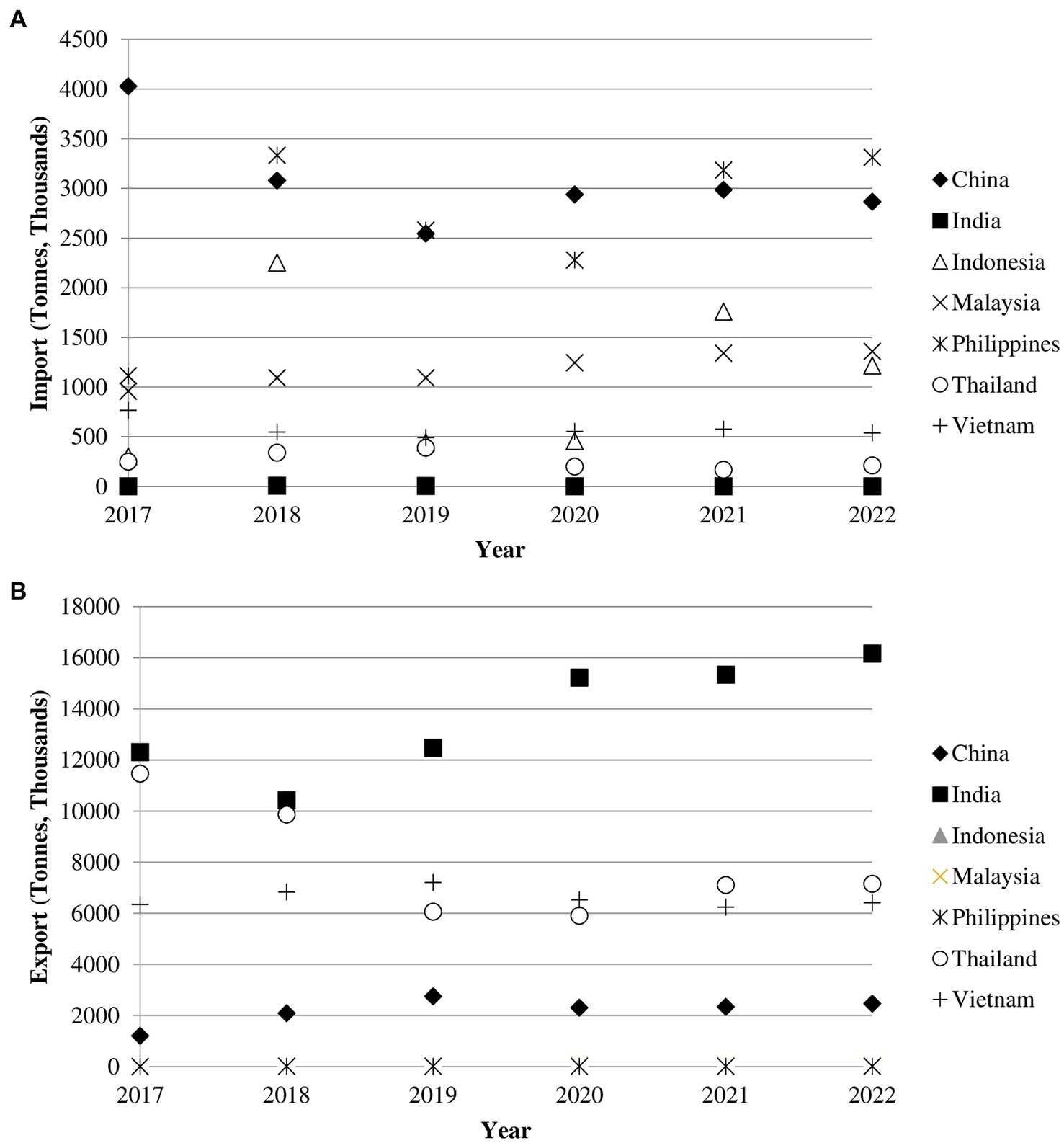
Figure 1. Rice import (A) and export (B) values in selected Asian countries from 2017 to 2022. Data for 2021–2022 are predictive. FAOSTAT.
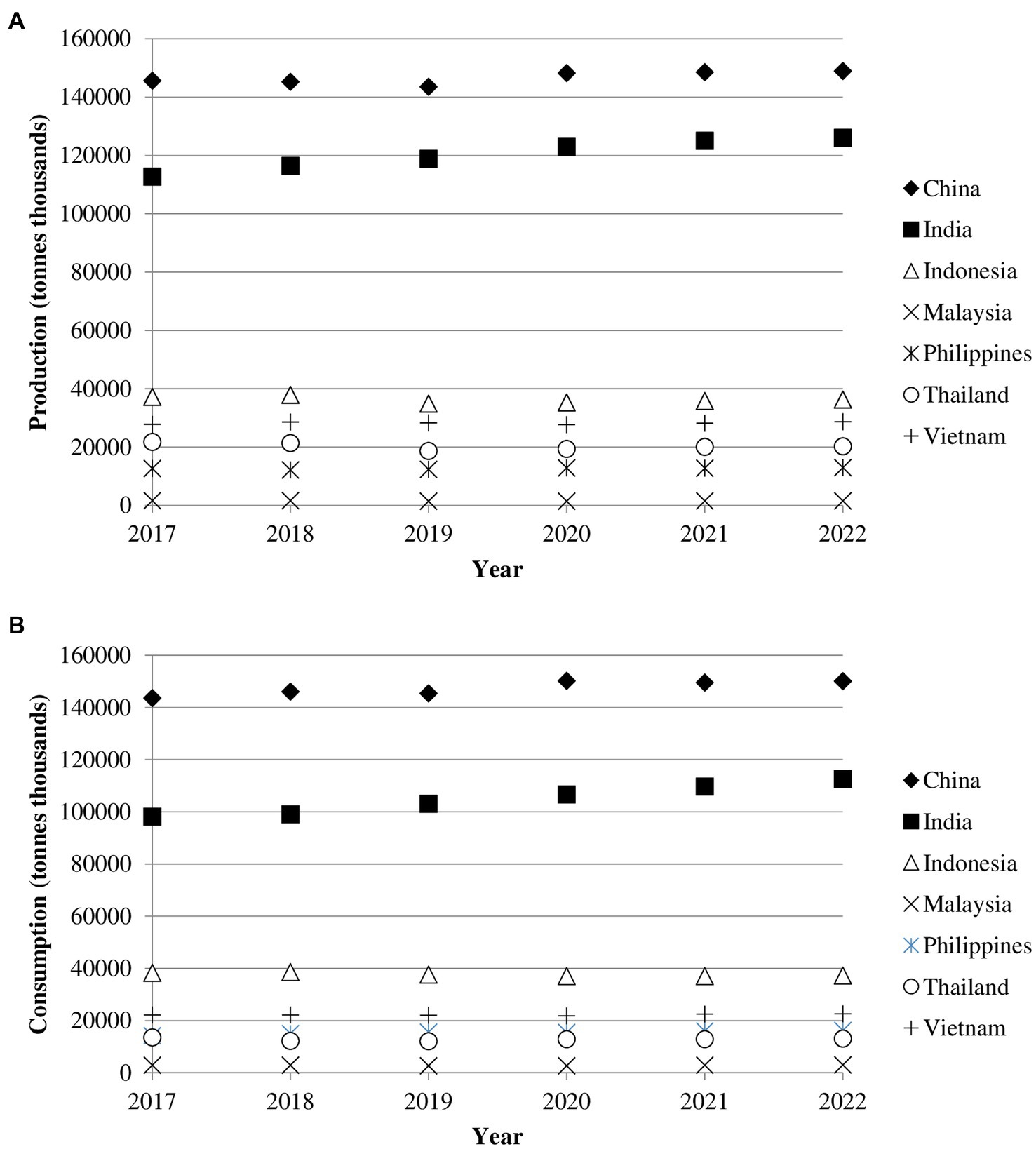
Figure 2. (A,B) Rice production and consumption in selected Asian countries from 2017 to 2022. Data for 2021–2022 are predictive. FAOSTAT.
Rice production systems are subjected to unique ecological and climatic conditions; rainfed and irrigated lowlands, uplands and deep-water areas. Major rice production comes from irrigated lowland rice system which accounts for 75% of the global rice yield (about 93 million ha). On the other hand, another 19% of the global rice yield is produced from 52 million ha of rainfed lowlands (GRiSP, 2013). Rice occupies about 46% of the total irrigated area in Asia, receiving about 40 and 30% of the world’s irrigation water and the world’s developed freshwater resources, respectively. As two-thirds of the total rice production is grown under the irrigated system (Maclean et al., 2002), rice production is increasingly constrained by water supply (Arora, 2006), coupled with increasing pressure over water use (global water crisis) in irrigation-supported rice production systems (Tuong and Bouman, 2003).
The increasingly growing shortage of water resources will throw a spanner in the work of the rice production system until and unless farmers switch to sustainable methods or technologies which could significantly increase the plant water use efficiency. Due to the unlimited water supply in the irrigated lowland rice systems, the average productivity of these granaries are much greater (about 5.4 t/ha) than rainfed lowland rice systems which yield around 1–2.5 t/ha (GRiSP, 2013). As for rainfed upland rice systems, the average yield fetches the lowest at 1 t/ha (GRiSP, 2013). Besides biotic and abiotic factors, social constraints and the use of local varieties by farmers that fail to respond favorably to environmental cues collectively result in low yield (Bouman et al., 2007). Finally, aerobic rice and upland rice are normally established by direct seeding in non-puddled and non-flooded fields (Tuong and Bouman, 2003). However irrigated upland rice cultivation is somewhat very limited while aerobic rice is only grown on about 80,000 hectares in China and 250,000 hectares in Brazil (Rao et al., 2017).
In developing countries such as Malaysia and Thailand, the heavily regulated and subsidized rice industry is equated to food security and political stability. In 2016, Malaysians consumed 2.7 million tonnes of rice, of which, 67% was produced locally while the balance was imported from neighboring countries (Thailand, India, Vietnam and Pakistan). In the aftermath of the COVID-19 pandemic, Thailand, also the biggest rice producer in the Southeast Asian region (self-sufficiency level = 200%) decided to discontinue its rice export to Malaysia in the quest for national-level food security reinforcement and domestic consumption. This in turn offered India, an opportunity to become Malaysia’s biggest rice partner. Malaysia’s rice supply is in mere jeopardy until or unless the nation hits a 100% SSL status. Rice is amongst the most thinly traded crop worldwide and thus, the country may not be sworn with a stable import rice supply under the umbrella of adverse environmental challenges and crises. Rice systems in Peninsular Malaysia are classified as high (>4 tonnes/ha) and low (<4 tonnes/ha) performing granaries and the yield differences among them are strongly influenced by farming practices, climate, pest and pathogen, soil native fertility and nutrient management. In this review, the rice and paddy industry in Malaysia is explored thoroughly, particularly on key aspects such as research trends and initiatives, farmers’ perception of technology adoption and governance and policy. Further, rice productivity constraints are highlighted and discussed along with realistic improvement strategies.
Rice cultivation in Malaysia
In Malaysia, rice is the third most important crop, after oil palm and rubber. Rice is planted twice (cropping seasons) annually. The main season (humid weather, Aug-Feb) is based on a non-irrigation-dependant system, whereas the off-season (dry weather, Mac-July) requires an irrigation system. Generally, rice granaries are distributed across Peninsular Malaysia, Sabah and Sarawak: (1) Muda Agricultural Development Authority (MADA), (2) Kemubu Agricultural Development Authority (KADA), (3) North Terengganu Integrated Agriculture Development (KETARA), (4) Project Barat Laut Selangor (PBLS), (5) Krian, (6) Seberang Perak, (7) Seberang Perai, (8) Kemasin, (9) Rompin, (10) Kota Belud and (11) Batang Lupar (Figure 4). Granaries are defined as rice farms with proper irrigation systems and land areas spanning >4,000 ha (Rahmat et al., 2019). Apart from these recognized granaries, there are 74 secondary granaries and 172 minor granaries distributed sporadically in Malaysia and contribute up to 28,441 and 47,653 hectares, respectively (Rahmat et al., 2019). In the Southeast Asian region, Malaysia has the smallest total rice planting area of 689,268 ha (Radin Firdaus et al., 2020), of which two third of the total planting area is distributed in Peninsular Malaysia and the remainder is found in Sabah and Sarawak (Ramli et al., 2012). Approximately 195000 farmers are toiling up in rice cultivation and productivity (Khazanah Research Institute, 2019).
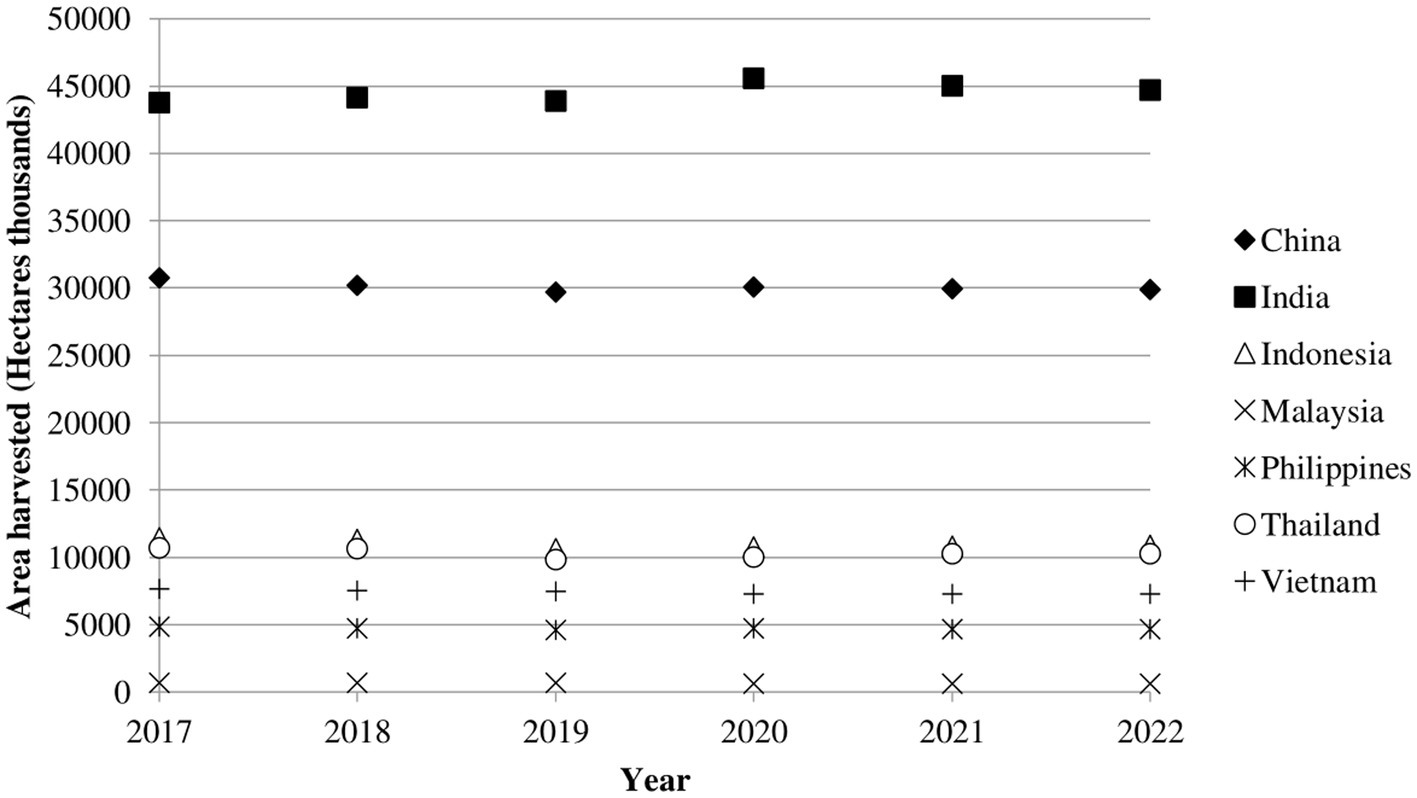
Figure 4. Rice harvest areas in selected Asian countries from 2017 to 2022. Data for 2021–2022 are predictive. FAOSTAT.
In early 2019, Malaysia’s paddy and rice production stood at 2.9 and 1.88 million MT, respectively while the self-sufficiency level (SSL) was reported at 72.85% (MARDI, 2010). According to Khazanah Research Institute (2019), Malaysians consumed 80 kg of rice per person which equalled to 26% of the total caloric intake per day. On average each household spends RM44/month (USD$ 9.93) on rice. Both Sabah (RM73/USD$16.50) and Perlis (RM13/USD$2.93) are ranked as states that spend the most and least on rice consumption, respectively.
Fast forward, the national SSL has now dipped slightly to 69% due to the looming pandemic which resulted in food supply chain disruption and increased consumption of staple food. While the population has increased to more than 32 million, rice production areas have remained relatively constant since the 1990s. Comparatively, the SSL of neighboring countries within the Southeast Asia region are significantly greater; Indonesia; SSL = 97%, The Philippines; SSL = 93% while Thailand, Vietnam and Cambodia have surplus production, with up to SSL > 200% (Khazanah Research Institute, 2019). Although rice production shows an annual growth of 1.6%, the small growth rate does not sufficiently meet the consumption need of the population. The national average rice yield hovers at 4.2 ton/ha while high-performing granaries such as IADA Barat Laut Selangor, IADA Pulau Pinang, IADA Ketara and MADA yield above 5.0 ton/ha, low-productivity granaries such as Kemasin, IADA Pekan and Rompin yield below 3.0 ton/ha (Ministry of Agriculture, 2016; Tables 1, 2). Kedah is the rice bowl of Malaysia as MADA contributes to half of the total paddy production of the nation (Figure 5).
Rice history, trading partners and governmental policies in Malaysia
Before independence (1957) the food policies in Malaysia were implemented to serve the colonial masters who focused mainly on plantation crops (oil palm, rubber and cacao) for export and foreign investments. There were no support programs dedicated to infrastructure development, and research and development. As the SSL of rice was below 50%, tapioca was the main source of carbohydrates for the poor (Ariffin, 2014). Post-independence, the Malaysian Agricultural Research and Development Institute (MARDI) was established to lead research on agriculture which included rice and paddy. In 1971, the National Board of Paddy and Rice (LPN) was formed to oversee the national rice supply and farmers’ welfare. The first notable milestone for the paddy industry was the construction of Muda Irrigation Project (1966–1970) which supplied water for the rice granaries in Kedah and Perlis. In 1994, LPN was corporatized to form Padiberas Nasional Berhad (BERNAS), the nation’s single rice gatekeeper (Khazanah Research Institute, 2019). The rice crisis in the 1970s set the tone for a blanket shield on rice production. Heavy subsidies, market control, guaranteed minimum price (GMP) for farmers, fixed retail ceiling price and import monopoly by BERNAS were triggered by this crisis.
The monopoly by the gatekeeper suppressed open market practices. In 1988, the World Bank raised a red flag on Malaysia’s market intervention approach which heavily caters for subsidies that burdens the economy and hence labelled the rice industry as both non-viable and unsustainable (World Bank, 1988). Moreover, higher spending on the cost of production did not necessarily translate into higher productivity (Zorya and Santos, 2014). According to other studies, if fertilizer subsidy is removed, the cost of production will increase, however, rice productivity is projected to drop (Ramli et al., 2012). Though many criticize these government policies, BERNAS as the guardian of the country’s rice stockpile had continuously protected the national rice sector against world market price fluctuations. Further, BERNAS keeps rice imports checked while ensuring that the farmers always have a buyer even when the demand is low. BERNAS is committed at sustaining a sufficient rice stockpile for the entire nation over a course of 45 days of buffering period. If indeed the domestic production drops, MoU is in place with Thailand and Vietnam as the next layer of insulation (Serin et al., 2019).
In 2008, main rice exporting countries such as Vietnam, India, China and Cambodia halted export to secure supply for domestic consumption. The international price for rice showed pronounced escalation during the fuel and financial crisis. This pressed the panic button on net rice importers such as Malaysia and the Philippines. The latter, which was also the world’s largest rice importing country, resorted to establishing trading with Thailand which decided to hike up the price to $700/metric tonne. The price then went up to $1,000/metric tonne when other neighboring countries joined the race to secure enough stockpiles of rice for their consumption. Before 2008, the price of rice hovered between $200-300/metric tonne (Tey, 2010).
Food security has always been on the agenda for food-related policies even before the latest food crisis. Various policies under different names were drawn to ensure the country does not go through another round of crisis. The National Food Security Policy and Agrofood Policy (2011–2020) were introduced to increase the national rice buffer stock (Serin et al., 2019). These policies were implemented in the interest of food security and to increase farmers’ income (Figure 6). In Malaysia, food security is equated to rice security and hence the government had mandated full SSL but to date, the values has been staggering around 70%. According to the United Nations Committee on world food security, all people at all times are physically, socially and economically accessible to sufficient, safe and nutritious food that meets their preferences and dietary needs for an active and healthy lifestyle (FAO, 1996). As previous food policies reached the end of its term, the current National Food Security Policy Action Plan (2021–2025) had vouched to embrace the five pillars of food security as per the UN’s definition: availability, accessibility, consumption, stability and sustainability. Under the Malaysian context, availability is referred to sufficient domestic rice production otherwise recognized, when all Malaysians consume locally produced rice, free from import dependence. Accessibility imparts equitable distribution among people and equal purchasing power. In this regard, the governance and regulatory policies in Malaysia have set the feedstock price of unhusked raw rice at a guaranteed minimum price (GMP). The selling price imposes a 20% deduction from the fresh weight of the unhusked rice grain which accounts for rice husk agro-waste. According to personal communications with local farmers, the selling price fluctuates in accordance with the grain quality, as well. The market price for a kilogram of rice has been ranging between RM3-6. The consumption and stability criteria are interconnected with availability and thus, are heavily modulated by the national rice productivity. Sustainable agricultural technologies build resilience to shocks and better manage trade-offs in food security during unprecedented times. The main thrusts for the paddy sector are to increase rice productivity via mechanisation, empowerment of research and technology, intensification of the use of rice by-products, improve the management of rice stockpile, and restructuring of the rice subsidies and incentives.
Rice farming in Malaysia: incentives, subsidies and market interventions
BERNAS acts as the buyer of last resort by procuring paddy from farmers at a GMP of RM1200/tonne. Farmers receive a subsidy of RM248.10 for every tonne of paddy that is harvested (unhusked rice grain), in addition to another RM650 per metric tonne, granted as a revenue incentive with at least a 1 % yield increase from the base season (Siwar et al., 2014). As for input subsidies, farmers get RM200/hectare for pesticide purchases. Further, farmers also receive 240 kg/ha of compound fertilizer and 80 kg/ha of urea fertilizer per hectare, and 100 kg/ha of organic fertilizer for cultivated rice (Harun, 2017). Apart from that, ploughing aid is paid at the rate of RM240/ ha (Er et al., 2021). These aids are a huge relief for the farmers as the average cost of production is about RM3024/hectare (Harun, 2017). The cost of production (COP) covers land rent, machinery, input cost and labour. According to the KRI report (2019), the cost of land rental and machinery is more than 30% of the total input cost which significantly affects the COP in each granary. These two variables have continuously shown increments over the years. In 2020, National Farmers Organisation (NAFAS) was appointed as the sole distributor for the Certified Paddy Seed Incentive to ensure farmers are not short-changed by the nine seed suppliers in the country. The ceiling price was set at RM35 per 20 kg of rice seeds to overcome price manipulation. Additionally, to cater for low-income households, the maximum retail prices of 15, 10 and 5% of broken rice were capped at RM1.80, RM2.40 and RM2.60 per kilogram, respectively (DOA, 2016).
Research and development: rice breeding for yield improvement
Before the 1960s, paddy farming was relatively traditional as the operation was heavily reliant on human labour and the use of buffaloes for ploughing. The Japanese occupation introduced off-season varieties such as Ryushu, Taichung 65, and Pebifun from Taiwan (Wasano, 1982) for large-scale rice cultivation. The first double-cropping variety, Malinja was released in 1964 which replaced single-cropping rice varieties such as Nachin 5,057 and Serendah Kuning. The traditional rice varieties were low yielding (1.4 t/ha) and hence necessitated a shift to double cropping varieties with improved yield (DOA, 2011). Development and breeding of rice varieties formally began in the 1970s with the establishment of the Malaysian Agricultural Research and Development Institute (MARDI). Nevertheless, national rice breeding programmes under the jurisdiction of the Department of Agriculture had released four rice varieties before the transfer of mandate: Malinja, Mahsuri, Ria and Bahagia. The average yield of these varieties was 2.47 t/ha, double the yield of traditional varieties. Malinja and Mahsuri were part of the largest japonica-indica rice hybridization project that aimed to enhance the yield component and fertilizer response in indica varieties via the integration of japonica’s inherent adaptive traits to local cultural conditions, diseases, and insects.
In the 1950s, Asia was on the brink of famine. In response to global food security, International Rice Research Institute (IRRI) actively embarked on a mission to develop high-yielding rice varieties (HYVs) in the 1960s. Various crosses between tall and dwarf rice planting materials were accomplished. Amongst which was the dwarfXtall cross between Dee-geo-woo-gen (dwarf variety from Taiwan) and Peta (tall variety from Indonesia). The discovery of a single recessive gene for shortness (sd-1) in the segregating F2 population led to the development of IR8-288-3 rice variety, after successful multi-location trials in the Philippines, Hong Kong, Malaysia, Thailand, and Taiwan (IRRI, 2016). The IR8 rice variety officially released in 1966 was touted as “miracle rice” as it kick-started Green Revolution in rice. Before the release of IR8, it was Dr. De Datta, an agronomist from India who chanced upon the possibility of maximizing yield by examining the fertilizer response of IR8 under dry season. The average rice yield came up to about 9.4–10.5 ton/ha which was 50% more than untreated IR8. Dr. Datta’s findings paved the route and laid a significant foundation for IR8 utilization as a prototype in the development of unique national rice varieties in Malaysia, Myanmar, Mexico, Indonesia and many other countries alike. In Malaysia, the Ria rice variety that was released by DOA in 1966 was based on IR8 which underwent massive rebranding (Chew and Shivanaser, 1972).
In Malaysia, rice cultivation with IR8 did not sustain long. Farmers refused and rejected to pursue IR8 as the major planting material in their fields due to its poor adaptability and rice quality (Varughese et al., 1982). Though anticipated to bring sheer joy, the IR8 cultivation turned into unprecedented shocks. As a result, farmers switched back to the use of old varieties (Mahsuri) that offered the promised rice quality and profitable cost of production. According to Baiti (1974), among other reasons that led to IR8 planting hesitancy among local farmers in Malaysia were high seed and labour costs, poor taste and low rice quality. These factors collectively affected the selling price apart other additional requirements such as precise field conditions as opposed to the existing natural conditions. Then came another HYV, namely IR5 (Bahagia) which had a similar yield to IR8 but exhibited better taste, was long-grained, required less seed and labour inputs, was easier to harvest and thresh and most importantly could be grown on existing field conditions (Baiti, 1974). Thereafter, the drawing board of breeders began scouting for locally adaptive parent planting materials for the development of HYV with better grain quality; Setanjung, Sekencang and Sekembang (Varughese et al., 1982).
The pioneering Malinja, Mahsuri and Bahagia varieties that were released by DOA before the establishment of MARDI were bred under the International Rice Commission programme. Selection of genotypes was done in farmers’ field and progressed further at the Rice Research Centre in Cuttack India; crossing and breeding of the F1 generation (Habibuddin, 2012). The phenotypic evaluation of the F2–F7 generations was conducted in Malaysia before the varieties were released (Nurul Nahar et al., 2020). Since transplanting and harvesting were done manually, these varieties were tall (ease the shattering process) and showed a total of 140 average days to reach maturity.
At this time, lodging was a serious concern among the local farmers. MARDI embarked on breeding for shorter varieties with an average culm height of 100–115 cm. Besides lodging, a host of plant diseases started cropping up, with blast, bacterial leaf blight, tungro and brown planthopper, to name a few. In 1979, the most preferred rice varieties, both Malinja and Mahsuri severely succumbed to panicle blast. In response to the undesirable yield lost, MARDI released the first blast resistant variety (Sekencang or MR7) against P. oryzae. Thereafter, various other blast resistant varieties emerged as preferred planting materials among the local farmers namely, MR 232, MR 253 and MR 263. These varieties were superior than the previously released varieties and were high yielding too. From 1990 to 2006, the focus of research and development activities shifted into selecting semi dwarf plants with an average culm height of 60–90 cm. The ultimate goal was to limit lodging with shorter plants. Hence, MR84 and MR219 with satisfying plant height and yield potential of 6–8 t/ha were released. For the record, from 1984 till 2002, about 97% of rice granaries in Malaysia were planted with MR84. After which, MR84 was displaced by MR219 which then gained preference as popular planting variety among local farmers, reigning for over last 20 years. Over time, rice breeding strategies gained significant momentum as evident through manipulation of various traits of interest: erect leaves, erect tillers, low tillering capacity, high germination rate, shorter plant height, better rooting structure and panicle-weight type rather than panicle-number type. Among the white rice varieties, the following were successfully bred as part of the high yielding rice production system: MR253, MR263, MR269, MR284, MR303. Few of these varieties were able to grow on marginal land, and conferred foliar and panicle blast resistant.
In 1999, aromatic rice MRQ50 was released to expand the rice niche market which was dominated by white rice. Progressing down the road, Mas Wangi (MRQ74) which resembled Basmathi was released thereafter. Comparatively, Mas Wangi displayed a much lower glycemic index and high GABA content than MRQ50. On the other hand MRQ76 (released in 2012) was akin to Jasmine rice. The pioneering glutinous rice varieties were Masria and Pulut Malaysia1 which were released in the 1970s whereas PH9 released in 1990 remained as the only black glutinous rice released in Malaysia.
While most varieties focused on disease resistance and high yielding, two Clearfield rice varieties namely MR220CL1 and MR220CL2 were released in 2010 to address weedy rice introgression. Clearfield rice varieties were tolerant to the toxic herbicide (imidazolinone) and displayed high yield at 6–9.5 ton/ha. Next, to address the issue of water shortage, an aerobic rice variety, MRIA1 that consume 50% less water was released. While all the rice varieties released by MARDI were pure inbred lines that were initially crossed with two or more different varieties followed by selection of self-pollinating generations till a uniform population plants are produced, hybrid rice is basically the F1 progeny (Jamal et al., 2013). The first 100% local hybrid rice Kadaria 1 developed based on cytoplasmic male sterility was the result of 7–8 years of intensive research and 21 seasons of multi-location trials (Jamal et al., 2013). F1 progenies display heterosis or hybrid vigor whereby a cross of two very genetically distant parents will produce offsprings that are far superior especially in yield (Teo). During trials, this hybrid rice was capable of producing 15–20% more rice in moderately fertile granaries (Jamal et al., 2013). In a pioneering trial at KADA, Kadaria managed to double the production, from 4 ton/ha to 8 ton/ha (Harian, 2019). It was predicted that this hybrid rice could yield up to 10 ton/ha in BLS granary.
While MARDI was mandated to lead the national rice breeding R&D, a couple of public universities joined the initiative to secure food security through the generous funding support offered by MOSTI and MOHE. Universiti Putra Malaysia (UPM) through funding from LRGS for Food Security released 2 rice varieties, namely PadiU Putra 1 and PadiU Putra 2 in 2017. The former is resistant to blast disease and has a yield potential of 12 ton/ha. It is the product of marker-assisted backcross breeding whereby broad-spectrum blast resistance genes (Piz, Pi2 and Pi9) were introgressed from local resistant rice variety (Pongsu Seribu 1) into high-yielding but highly blast-susceptible (MR219). The rice cultivar MR219 was used as the recurrent parent, and Pongsu Seribu 1 was used as the donor (Miah et al., 2017). As for PadiU Putra 2, a submergence-tolerant rice variety which could withstand flood, it was developed through marker-assisted backcrossing method. MR219 was used as the recurrent parent while Swarna-Sub1 which possessed the trait for submergence tolerance was the donor; Sub1 gene is the gene for submergence tolerance (Ahmed et al., 2016).
Universiti Kebangsaan Malysia (UKM) was the first in the country to release cross-breed rice varieties by crossing O. sativa (MR219 variety) with the wild rice, O. rufipogon. Both UKMRC2 and UKMRC8 are bred through advanced backcrossing techniques. These high-yielding varieties (12–14 ton/ha) are resistant to blast and are submergence tolerant (Sabu et al., 2006). Besides high-quality white rice, UKM had successfully released a superior red rice variety that is marketed as Primera (UKMRC9). This was the result of conventional breeding which involved controlled cross-breeding between cultivar MR219 and wild rice O. rufipogon. UKMRC9 is suitable for the consumption of diabetic patients as it has a low glycemic index and high antioxidants (Se et al., 2016). In addition to the three varieties above, the University had released three other rice varieties. A descriptive list of rice varieties released in Malaysia is provided in Table 3.
Resilience: addressing pests and diseases across Malaysian rice granaries
Pests and diseases such as the rice blast disease, bacterial leaf blight, tungro and brown plant hopper are constant threats to the rice production systems in Malaysia (Mispan et al., 2019). In 2015, accounting for 43% of total rice disease incidence, Rosnani et al. (2015), reported blast disease as the most predominant disease affecting rice cultivation. Blast disease caused by the Pyricularia oryzae Carava [teleomorph: Magnaporthe grisea (Herbert) Barr] fungus is categorized into two types based on host preference: (i) foliar blast; infects at the rice seedling stage and (ii) panicle blast; infects the panicle during the reproductive stage. The disease occurrence, distribution and infestation is weather-driven. The first incidence of blast disease in Peninsular Malaysia was reported in 1945 (Habibuddin, 2012) following a 70% yield loss observed on Jaya, a susceptible rice variety (Nurul Nahar et al., 2020). Besides Jaya, Sekencang and Setanjung too succumbed to panicle blast which reduced grain filling, panicle breakage and subsequent yield loss (Chuwa et al., 2014; Latiffah and Norsuha, 2018). In 2011, the blast resistant MR219 succumbed to panicle blast in MADA granary (Zakaria and Misman, 2018) while in 2017, Norlida (2017) reported that a total of 1,453 ha and 957 ha of rice fields were infected by leaf blast and panicle blast, respectively. The most infected granary was KADA followed by MADA and IADA BLS. MARDI had since then released MR253, MR263, MR269 and MR284 with improved disease resistance. Besides these varieties, MR297 also known as Siraj conferred blast resistant, tungro resistant and BPH moderate resistant (Zakaria and Misman, 2018).
The bacterial leaf blight disease (BPH) caused by Xanthomonas oryzae pv. oryzae (Xoo) is assumed to be the oldest and most important disease in rice history (Chukwu et al., 2019). BPH is characterized with wilting of paddy seedlings and/or yellowing/drying of the leaves (Afolabi et al., 2016). Farmers’ first encountered BPH in 1980s (Sankaran et al., 2010), however, over the decade, no reports of the disease incidence were observed. In the recent years, the disease re-emerged and reared its ugly head on at least 12,080 ha of rice fields in Peninsular Malaysia (DOA, 2019). Similar to blight disease, Shamsudin et al. (2019) reported 30–50% potential loss of yield due to bacterial leaf blight (BLB) disease infection. The most severe leaf blight disease outbreak in the last 30 years occurred in the paddy field of Sekinchan, Selangor, in 2016 causing 50–70% loss of yield (Toh et al., 2019). During the outbreak, the farmers had planted the new variety MR284 that was released just a year ago. In 2017, another type of blight, namely bacterial panicle blast (BPB) caused by Burkholderia glumae (Goto and Ohata, 1956; Urakami et al., 1994) showed up at Ache River, Penang and a year later in Kelantan (Ramachandran et al., 2021). BPB infected rice plants have upright panicles, florets with darker basal portion of the glumes, and reddish–brown border across the florets. According to MARDI, granaries in various states in Peninsular Malaysia have recorded up to 50% losses due to BPB. As for sheath blight (ShB), Rhizoctonia solani is the soilborne necrotrophic fungal causative agent that is responsible for yield loss of up to 45% (Margani and Widadi, 2018). The symptoms are the formation of lesions on the sheath leading to softness and lodging of the sheath and inhibition of grain filling (Wu et al., 2012).
Besides blast and blight, the rice plants have always been prone to tungro disease (Penyakit virus merah) that is transmitted by green leafhopper, Nephotettix virescens (Kobayashi et al., 1983). The disease results from an infection by two distinct viruses, Rice tungro bacilliform virus (RTBV) and Rice tungro spherical virus (RTSV) (Habibuddin et al., 1997). Although the symptoms of yellow-orange leaf discoloration, plant stunting and reduced yield were recognized since 1934, but its viral nature only came to light in 1965 (Kobayashi et al., 1983). Despite the significance of tungro disease, very little work has gone into understanding it except for the first genome sequencing of RTBV undertaken in 1999 (Marmey et al., 1999). Annually almost US$1.5 billion is lost worldwide while in Asia about 10% of loss in rice yield had been attributed to this disease (Dai and Beachy, 2009).
Besides green planthopper, the brown planthopper has been a constant menace (Matteson, 2000). Nilaparvata lugens causes the notorious brown plant hopper (BPH) disease that is touted to cause a loss of 90,000 ton/season which is valued at about RM 72 million. BPH directly feed on rice plants and transmits the grassy stunt disease (Dyck and Thomas, 1979). As for brown spot disease, the causal agent is Bipolaris oryzae (telemorph = Cochliobolus miyabeanus). It affects direct seeded rice plants and could potentially lead to 90% yield loss if water supply is scarce or limited and there is an inadequate supply of nitrogen (Baranwal et al., 2013). Although brown spot is commonly observed on the leaves and glumes (grain husks) (Ou, 1985), it could also affect other plant parts, namely leaf, coleoptile, sheaths, panicle branches and grain. According to Sunder et al. (2014) the pathogen causes brown to dark brown lesions on panicle stalk at the joint of flag leaf to stalk. As the disease progresses, the pathogen retards plant growth, forms visible grain discoloration, reduces the number of grains per panicle and grain weight, and increases the number of empty grains (Valarmathi and Ladhalakshmi, 2019).
The common disease management approach is cultural practices and use of chemical but often times it fails to combat the disease at the bud. It is imperative to use disease resistant rice varieties as host resistance is the best strategy to cut yield losses and ensure the sustainability of rice and paddy industry (Wu et al., 2020). Additionally, the use of certified quality seeds is mandatory to curb yield losses. A list of common rice diseases in Malaysian granaries is presented in Table 4 with the inclusion of each disease description.
Resilience: soil health, a key determinant to paddy and rice production
Rice productivity gain is driven by soil quality. Soil quality variables which includes bulk density, organic carbon content, nutrient element content, soil porosity, soil aggregate stability index and others are key determinants of the overall rice growth performance and productivity. In general, rice cultivation techniques, diversified crop cultivation pattern which integrates alternative upland crop planting via rotation has long been associated with soil quality improvement, however, no such methods are practiced in Malaysia. Rice growing areas in Malaysia are distributed in a wide range of soil types: organic clay, brown clay, Jawa, Sedu, Bakau, Bernam, Serong and others. These soil types varies by their unique rhizosphere microbiome and inherent nutrient composition. In high performing rice granaries such as Sabak Bernam and Tanjung Karang disricts, the soils are generally less acidic (pH 4–5) compared to low performing rice granaries (pH < 4).
The soil acidity level increases with the oxidation of pyrite-bound sediments distributed mainly in the coastal plains of Malaysia. Acid-sulfate soil (ASS) contains pyrite (FeS2) which releases sulfuric acid upon oxidation. It is high in aluminium and iron content and deficit in phosphorus. Pyrite oxidation causes sulfuric acid drainage and dissolves the bioavailable iron for plant uptake. As a result, plant nutrition and subsequent growth and development are adversely affected. Agricultural ASSs are subjected to amelioration with basalt, ground magnesium, limestone and organic compounds as a soil pH corrective measure. Rice granaries distributed on ASS are treated using lime sources such as ground magnesium limestone (GML), hydrated lime and liquid lime. Liming increases the cost of production as at least 4 tonnes of GML per ha is required for a decent production of 3.5–4 t ha of rice under ASS system.
Resilience strategies: the Malaysian Good Agriculture Practices (MyGAP)
Sustainable agriculture and food safety are the cores of good agricultural practice (GAP). First mooted by FAO in 2003 (FAO, 2003), this practice not only focuses on preserving the environment, but also accounts for the welfare, safety and labour health (Ali et al., 2020). In Malaysia, the first certification scheme constructed based on Malaysian Standard MS 1784:2005 Crop Commodities – Good Agriculture Practices (GAP) known as Good Practice Scheme of Malaysia (SALM) was drawn up by Department of Agriculture in 2002. Under rebranding measure, SALM became MyGAP in 2013 (My = Malaysia). For a farm to be certified, it is evaluated on the aspects of its environmental setting, verification of farm practices and safety of farm products, incorporating traceability and ensuring adequate workers’ welfare within the farm (Department of Economics Malaysia, 2009). As the benchmark for MyGAP is against the international GAP certification scheme, it allows for Malaysian produce to penetrate into the global market and gain better recognition and acceptance (Mohamed et al., 2016). However, the numbers for paddy farms adopting this scheme is very low for the farmers being old and used to conventional farm practices are inept in precision farming or precise application of fertilizer inputs (Chee-Wan and Meng-Chang, 2012). Also the lack of incentive or very little incentive to acquire farming mechanization had derailed the farmers. Based on a study on 80 paddy farmers, 80% practiced unsustainable paddy farming with a score of less than 40.0 on a scale of 0–100, 2.5% in the range of intermediate sustainability with none of the farmers close to being sustainable (Mohamed et al., 2016). The result is an indication that farmers were not following the Paddy Check guideline and are using excessive fertilizer, pesticide, and herbicide which contravened MyGAP (Table 5). Generally, farmers are receptive of sustainable agriculture as it compromises on profitability and maximizing productivity. Moreover, the lack of support for the certification was also due to the failure to differentiate myGAP and non-MyGAP rice. The non-existent reward for good quality and safe rice produced in a sustainable manner had dampened not only the MyGAP practitioners but also discouraged other farmers from adopting the stringent guideline. But all is not doom and gloom, since recently in May 2021, the first MyGAP rice grown in KETARA, Terengganu hit the market (BERNAMA, 2021).
Service models for rice farming in Malaysia
In recent years, unmanned aerial vehicles or drones have become an important tool for precision agriculture. According to the US-based 1996 Association for Unmanned Vehicle Systems International, 80% of the future drone market is expected to engage in agriculture sector (Association for Unmanned Vehicle Systems International, 2013). Drone platform offers opportunities to fetch a wide array of agronomically important datasets; soil analysis, mapping and detection of outliers, irrigation, spraying and planting of plants (Zhu et al., 2021). In rice, the above ground biomass which accounts for yield-related traits such as number of panicles, spikelets/grains per panicle, percentage of filled kernels/grains, grain weight and others, cumulatively determine the yield potential of rice at a given growing cycle. Effective monitoring of yield-related traits is particularly important to gain insights into crop growth stability and yield.
Rice cultivation in Malaysia has a long history of being dominated by small farmers. Generally, they can be classified into five different groups based on the land hold area: marginal; < 1 hectare, small; 1–2 hectare, semi-medium; 2–4 hectare, medium; 4–10 hectares and large land holders with >10 hectares. In Malaysia, drone technology for agriculture is mainly employed in private sectors. Although the drone industry had established a broad niche of application in agricultural systems (oil palm, mainly), the impact on Malaysian rice farmers is relatively minimal at engagement in sprayer drones solely. Sprayer drones are used to facilitate timely application of fertilizer, pesticides and other chemicals alike. Professional drone users do not hail from the farmers community. Spray drones are offered as service models and are mostly distributed in the high performing rice granaries in Malaysia (Tanjung Karang, Sekinchan). Since drone technology is gaining attention, paving new directions in modern rice farming, more youngsters are pursuing technical courses which are readily available locally. For example, the My Drone Services offers technical courses (basics for drone user and agriculture pilot drone) on the handling, maintenance and management of drones. Similar courses (professional drone navigator) are also organized at the community college levels (eg. Kolej Komuniti Sabak Bernam, Selangor). On a daily basis, an average 10 l capacity drone could cover up to 10 hectares of paddy field. The charges are based on area size covered; RM12-20 (USD$2.70–4.50) for a quarter of an hectare. In a personal communication with local farmers (Feb 2020) in Tanjung Karang, drones were favored for the fast spraying efficiency which subsequently improved rice production via mitigation of pest, disease and lodging.
Future prospective and opportunities toward crop improvement and greater productivity
The Malaysian rice farmers are mainly older adults in their 50s and 60s. Youth (less than 40 years) participation in Malaysian rice and paddy cultivation is insignificant as they represent less than 17% of the total farmers population. Literacy wise, farmers aged 60 and above had received up to secondary schooling only. These farmers are comfortable with easy handling tools such as straw cutter, weeding machine and ploughing machine catered at the production level (Yaacob et al., 2019). In general, the utilization of farming tools remains traditional and no apparent application of high-end technology had been practiced. Since most of these farmers belong to the small-scale rice farming group with low buying power, they are highly dependent on the incentives and subsidies provided by the federal government (Adnan et al., 2017). Hence, only large-scale rice farm owners with higher buying power are keen in purchasing and owning modern equipment (eg. harvester). In a survey conducted in the MADA rice granary, 65% of the total respondent (rice farmers) above 51 years old showed positive acceptance to technology despite noting the difficult handling procedure. Undeniably, technology carries a toll on the cost of production. Precision rice agriculture by MARDI offer various technologies for land levelling systems, seed sowing coupled with conversion rate, yield monitoring and early warning system and fertilization technology package. Amongst the most popular accepted? technology developed by MARDI is the levelling technology package and variable rate seedling which costs RM225/ha (USD$50.50). Even among the paddy farmers with fairly good acceptance to precision technologies, the rising cost of production is a big stumbling block, crossing into their profit margin.
As we discuss about food, we can never escape from the controversy surrounding the use of chemical fertilizers (Food and Agricultural Organisation, 2004). The usage of chemical or inorganic fertilizer is widespread and common for the cost-effective production of agricultural crops (Palanivell et al., 2016; Tanaka et al., 2020). It ensures bountiful harvests at affordable costs but at the expense of human health and our ecosystem. Besides, rice farming is highly polluting since hundreds of millions of tons of rice husk and straw are produced along the cycle. The open burning of these wastes leads to air pollution and emission of greenhouse gases (GHGs) mainly due to incomplete combustion (Romasanta et al., 2017). Hence, a paradigm shift to a greener agricultural practice is needed to ensure sustainability and clean environment. As the country moves toward developed status, green fertilizers and nanotechnology offer potential solution for sustainable agriculture (Behl et al., 2022). The utilization of nanomaterials for precision agriculture will cut on nutrient losses during fertilization and reduce the use of chemical fertilizers and pesticides by controlled release of nutrients, fertilizers and pesticides (Fraceto et al., 2016) while elevating productivity (Fraceto et al., 2016; Adnan and Nordin, 2021). Circular economy promotes the shift toward sustainable waste management, hence to use the waste products of paddy farming, such as the rice husk is commendable since this practice of value creation will indirectly cut on carbon footprint while embracing multiple SDGs. The steering away of chemical fertilizer will ensure not only a cleaner food chain but will put waste material into beneficial agriculture input to enhance productivity.
Conclusion
The long history of Malaysian rice farming was established at the pre-independence era. In the 1960’s, soils in Peninsular Malaysia were ranked amongst the most superior quality in terms of organic matter factor. The swampy condition of west coast facilitated accumulation of soil organic matter (SOM). Long standing research on improved rice planting materials are primarily conducted using traditional breeding programmes. Government policy and support for a productive rice system is most evident through the implementation of Paddy Production Incentive Schemes and Guaranteed Minimum Price standardization under the paddy supply chain. Despite differences in environmental factors, mainly soil fertility, rice domestic trading has been serving equal in both high and low performing rice granaries. Farmers (>50 years old) are the main actors of rice agricultural system, however, technology-enabled farming practices are least observed (Rahim et al., 2018). On a global perspective, the rice industry in Malaysia fall behind in regard to yield and productivity as a result of unattended/widening gaps in the utilization of genetically-modified (GM) planting materials, nano fertilization and technology-driven farming practices (Vaghefi et al., 2016; Masilamany et al., 2021; Sabran and Abas, 2021). There is an urgent need to understand the GM-hesitancy culture among local farmers and educate them accordingly. Ultimately, farmers are the backbone support for rice research & development activities in Malaysia. It takes two hands to clap. Likewise, it takes effective farmer-researcher communication for meaningful laboratory to farm translational research and acceptance.
Author contributions
DD and NTG analyzed the data, wrote, read and approved the manuscript. All authors contributed to the article and approved the submitted version.
Funding
This work was funded by the Geran Galakkan Penyelidik Muda GGPM-2021-048 by Universiti Kebangsaan Malaysia.
Acknowledgments
The financial support by GGPM-2021-048 and Dana Pecutan Penerbitan, Universiti Kebangsaan Malaysia are duly acknowledged.
Conflict of interest
The authors declare that the research was conducted in the absence of any commercial or financial relationships that could be construed as a potential conflict of interest.
Publisher’s note
All claims expressed in this article are solely those of the authors and do not necessarily represent those of their affiliated organizations, or those of the publisher, the editors and the reviewers. Any product that may be evaluated in this article, or claim that may be made by its manufacturer, is not guaranteed or endorsed by the publisher.
Glossary
References
Adnan, N., and Nordin, S. M. (2021). How COVID 19 effect Malaysian paddy industry? Adoption of green fertilizer a potential resolution. Environ. Dev. Sustain. 23, 8089–8129. doi: 10.1007/s10668-020-00978-6
Adnan, N., Nordin, S. M., and Abu-Bakar, Z. (2017). Understanding and facilitating sustainable agricultural practice: a comprehensive analysis of adoption behaviour among Malaysian paddy farmers. Land Use Policy 68, 372–382. doi: 10.1016/j.landusepol.2017.07.046
Afolabi, O., Amoussa, R., Bilé, M., and Oludare, A. (2016). First report of bacterial leaf blight of rice caused by Xanthomonas oryzae pv. oryzae in Benin. Plant Dis. 100:515. doi: 10.1094/PDIS-07-15-0821-PDN
Ahmed, F., Rafii, M., Ismail, M., Juraimi, A. S., Rahim, H. A., Latif, M., et al. (2016). The addition of submergence-tolerant Sub 1 gene into high yielding MR219 rice variety and analysis of its BC2F3 population in terms of yield and yield contributing characters to select advance lines as a variety. Biotechnol. Biotechnol. Equip. 30, 853–863. doi: 10.1080/13102818.2016.1192959
Ali, M., Man, N., Muharam, F. M., and Omar, S. Z. (2020). Factors influencing behavioral intention of farmers to use ICTs for agricultural risk management in Malaysia. Pak. J. Agri. Res. 3:295.
Ariffin, T. (2014). The review of the paddy and rice industries submitted to economic planning unit, Prime Minister’s Department. Serdang: Marditech Corporation Sdn. Bhd.
Arora, V. K. (2006). Application of a rice growth and water balance model in an irrigated semi-arid subtropical environment. Agric. Water Manag. 83, 51–57. doi: 10.1016/j.agwat.2005.09.004
Association for Unmanned Vehicle Systems International. The economic impact of unmanned aircraft systems integration in the United States. AUVSI, Washington, DC. (2013).
Baiti, UN. (1974). Use of high yielding rice variety in Malaysia. International Rice Research Conference, IRRI, Los Banos, Phillipines April 22–25
Baranwal, M. K., Kotasthane, A., Magculia, N., Mukherjee, P. K., Savary, S., Sharma, A. K., et al. (2013). A review on crop losses, epidemiology and disease management of rice brown spot to identify research priorities and knowledge gaps. Eur. J. Plant Pathol. 136, 443–457. doi: 10.1007/s10658-013-0195-6
Behl, T., Kaur, I., Sehgal, A., Singh, S., Sharma, N., Bhatia, S., et al. (2022). The dichotomy of nanotechnology as the cutting edge of agriculture: nano-farming as an asset versus nanotoxicity. Chemosphere 288:132533. doi: 10.1016/j.chemosphere.2021.132533
BERNAMA. (2021). Beras MyGap keluaran Terengganu dipasarkan Mei ini. Harian Metro. Available at: https://www.hmetro.com.my/agro/2021/03/689266/beras-mygap-keluaran-terengganu-dipasarkan-mei-ini
Bouman, B., Barker, B., Humphreys, E., and Tuong, T. P. (2007). “Rice: feeding the billions” in Comprehensive assessment of water management in agriculture. Water for food, water for life: A comprehensive assessment of water management in agriculture, Earthscan, London and International Water Management Institute, Colombo, 515–549.
Chee-Wan, C., and Meng-Chang, C. (2012). Country report: Malaysia ; Kuala Lumpur, Malaysia: Asia Pacific Economic
Chukwu, S. C., Rafii, M. Y., Ramlee, S. I., Ismail, S. I., Hasan, M. M., Oladosu, Y. A., et al. (2019). Bacterial leaf blight resistance in rice: a review of conventional breeding to molecular approach. Mol. Biol. Rep. 46, 1519–1532. doi: 10.1007/s11033-019-04584-2
Chuwa, C. J., Mabagala, R. B., and Reuben, M. S. O. W. (2014). Assessment of grain yield losses caused by rice blast disease in major rice growing areas in Tanzania. Int. J. Sci. Res. 4, 2211–2218.
Dai, S., and Beachy, R. N. (2009). Genetic engineering of rice tungro disease. In Vitro Cell. Dev. Biol. Plant 45, 517–524. doi: 10.1007/s11627-009-9241-7
Department of Agriculture (DOA). (2019). Buku statistik makanan (Sub-sektor tanaman makanan). Data siri masa lima tahun (2015 - 2019). Kementerian Pertanian dan Industri Asas Tani, Malaysia.
Department of Agriculture Malaysia (DOA). (2016). Paddy statistics of Malaysia, 2015. Department of Agriculture Peninsular Malaysia, Putrajaya.
Dyck, V.A., and Thomas, B. (1979). The brown planthopper problem. In: Brown planthopper: Threat to rice production in Asia. Proceedings international Rice research institute. Los Banos, Laguna Philippines.
Er, A. C., Ahmad, H., and Manaf, A. A. (2021). Comparative cost benefit analysis of conventional farming and agroecological farming for paddy cultivation in Bachok, Kelantan. Int. J. Environ. Sci. Develop. 12, 181–187. doi: 10.18178/ijesd.2021.12.6.1338
FAO/UNEP. (1996). Our Land Our Future: A New Approach to Land Use Planning and Management. FAO/UNEP, Rome.
FAO. (2003). Report of the expert consultation on a good agricultural practices (GAP) approach. FAO Agriculture Department Report Rome: Food and Agriculture Organization of the United Nations.
FAO (2004). The state of agricultural commodity markets. Available at: http://www.fao.org/
Food and Agricultural Organisation. (2004). FAOSTAT Database. Rome: Food and Agricultural Organization.
Food and Agricultural Organisation. (2020). FAOSTAT Database. Rome: Food and Agricultural Organization.
Fraceto, L. F., Grillo, R., de Medeiros, G. A., Scognamiglio, V., Rea, G., and Bartolucci, C. (2016). Nanotechnology in agriculture: which innovation potential does it have? Front. Environ. Sci. 4:20. doi: 10.3389/fenvs.2016.00020
Global Rice Science Partnership (GRiSP) (2013). Rice almanac, 4th International Rice Research Institute, Los Baños, p. 283
Goto, K., and Ohata, K. (1956). New bacterial diseases of rice (brown stripe and grain rot). Ann. Phytopathol. Soc. Jpn. 21, 46–47.
Habibuddin, H. (2012). Managing pests and diseases of rice using resistant varieties. Serdang, Malaysia: MARDI Press, 45.
Habibuddin, H., Mahir, A. M., Ahmad, I. B., Jalani, B. S., and Imbe, T. (1997). Genetic analysis of resistance to rice tungro spherical virus in several rice varieties. J. Trop. Agric. Food Sci. 25, 1–7.
Harian, Berita. (2019). Kadaria 1 tingkatkan hasil padi 10 tan sehektar. Available at: https://www.bharian.com.my/berita/nasional/2019/10/623484/kadaria-1-tingkatkan-hasil-padi-10-tan-sehektar
Harun, R. (2017). Policies and economic development of rice production in Malaysia. Available at: http://ap.ftc.agnet.org/fles/ap_policy/393/393_1.pdf.
IRRI (International Rice Research Institute) (1995). Rice Facts. Los Banos: International Rice Research Institute.
IRRI, Africa Rice and CIAT (2010) Global Rice Science Partnership (GRiSP). CGIAR thematic area 3: Sustainable crop productivity increase for global food security. A CGIAR research program on rice-based production systems. IRRI, Africa Rice, Benin and CIAT, Colombia, Philippines
Jamal, K., Kamarulzaman, N. H., Abdullah, A. M., Ismail, M. M., and Hashim, M. (2013). Farmer’s acceptance towards fragrant rice farming: the case of non-granary areas in the East Coast. Malaysia. 20, 2895–2899.
Khazanah Research Institute. (2019). The status of the paddy and rice industry in Malaysia. Kuala Lumpur: Khazanah Research Institute.
Kobayashi, A., Mohd Amin, S., and Omar, O. (1983). Inheritance of resistance of rice to tungro and biotype selection of green leafhopper in Malaysia. JARQ 16, 306–311.
Ladha, J. K., Rao, A. N., Raman, A. K., Padre, A. T., Dobermann, A., Gathala, M., et al. (2015). Agronomic improvements can make future cereal systems in South Asia far more productive and result in a lower environmental footprint. Glob. Chang. Biol. 22, 1054–1074. doi: 10.1111/gcb.13143
Maclean, D.C., Dawe, B., and Hettel, G.P. (2002). Rice Almanac, International Rice Research Institute, Los Banos, Philippines, 3rd, 2002.
Masilamany, D., Hamdani, M. S. A., Rahim, H., and Chuah, T.-S. (2021). Survey on weedy rice (Oryza sativa) management practice and adoption of Clearfield rice technology in Peninsular Malaysia. Weed Sci. 69, 1–23.
MARDI. (2010). Rice R&D at MARDI. Available at: http://www.mada.gov.my/wp-content/uploads/2019/09/lawatan-delegasi-filipina2-edited-140119-1.pdf
Margani, R., and Widadi, S. (2018). “Utilizing Bacillus to inhibit the growth and infection by sheath blight pathogen, Rhizoctonia solani in rice” in IOP conference series: Earth and environmental science, vol. 142, No. 1 (Bristol: IOP Publishing)
Marmey, P., Bothner, B., Jacquot, E., de Kochko, A., Ong, C. A., Yot, P., et al. (1999). Rice tungro bacilliform virus open reading frame 3 encodes a single 37-kDa coat protein. Virology 253, 319–326. doi: 10.1006/viro.1998.9519
Matteson, P. C. (2000). Insect pest management in tropical Asian irrigated rice. Annu. Rev. Entomol. 45, 549–574. doi: 10.1146/annurev.ento.45.1.549
Miah, G., Rafii, M. Y., Ismail, M. R., Puteh, A. B., Rahim, H. A., and Latif, M. A. (2017). Marker-assisted introgression of broad-spectrum blast resistance genes into the cultivated MR219 rice variety. J. Sci. Food Agric. 97, 2810–2818. doi: 10.1002/jsfa.8109
Ministry of Agriculture (MOA). (2016). Dasar Sekuriti Makanan Negara (in bahasa). Putrajaya: Ministry of Agriculture and Agro-based Industry.
Mispan, M. S., Bzoor, M. I., Mahmod, I. F., Md-Akhir, A. H. B., and Zulrushdi, A. Q. (2019). Managing weedy rice (Oryza sativa L.) in Malaysia: challenges and ways forward. J. Res. Weed Sci. 2, 149–167. doi: 10.26655/jrweedsci.2019.3.6
Mohamed, Z., Terano, R., Shamsudin, M., and Latif, I. A. (2016). Paddy farmers’ sustainability practices in granary areas in Malaysia. Resources 5:17.
Muthayya, S., Sugimoto, J. D., Montgomery, S., and Maberly, G. F. (2014). An overview of global rice production, supply, trade, and consumption. Ann. N. Y. Acad. Sci. 1324, 7–14. doi: 10.1111/nyas.12540
Norlida, A. I. (2017). 2,410 hektar padi di Kedah dan Perlis diserang penyalit karah daun, tangkai. Kuala Lumpur, Malaysia: Kosmo.
Nurul Nahar, E., Adam, P., Mazidah, M., Roslan, I., and Mohd, R. Y. (2020). Rice blast disease in Malaysia: options for its control. Journal of tropical agriculture and food. Science 48, 11–23.
Palanivell, P., Ahmed, O. H., and Ab-Majid, N. M. (2016). Minimizing ammonia volatilization from urea, improving lowland rice (cv.MR219) seed germination, plant growth variables, nutrient uptake, and nutrient recovery using clinoptilolite zeolite. Arch. Agron. Soil Sci. 62, 708–724. doi: 10.1080/03650340.2015.1077229
Radin Firdaus, R. B., Tan, M. L., Rahmat, S. R., and Gunaratne, M. S. (2020). Paddy, rice and food security in Malaysia: a review of climate change impacts. Cogent Soc. Sci. 6:1818373. doi: 10.1080/23311886.2020.1818373
Rahim, H., Wahab, M. H. M. A., Amin, M. Z. A., Harun, A., and Haimid, M. T. (2018). Perception and acceptance of farmers in precision farming technology in selected granary area. Econ. Technol. Manag. Rev. 13, 97–110.
Rahmat, S. R., Radin Firdaus, R. B., Mohamad Shaharudin, S., and Lim, Y. L. (2019). Leading key players and support system in Malaysian paddy production chain. Cogent Food Agric. 5:1. doi: 10.1080/23311932.2019.1708682
Ramachandran, K., Vijaya, S. I., Ahmad, F. N. A., and B, & Zakaria, L., (2021). Characterization and identification of Burkholderia glumae as the causal pathogen of bacterial panicle blight of rice (Oryza sativa L.) in Malaysian rice granaries. J. Gen. Plant Pathol. 87, 164–169. doi: 10.1007/s10327-021-00991-1
Ramli, N. N., Shamsudin, M. N., Mohamed, Z., and Radam, A. (2012). The impact of fertilizer subsidy on Malaysia paddy/rice industry using a system dynamics approach. Int. J. Soc. Sci. Hum. 2:3.
Rao, A. N., Wani, S. P., Ramesha, M. S., and Ladha, J. K. (2017). “Rice production systems” in Rice production worldwide. eds. B. S. Chauhan, K. Jabran, and G. Mahajan (Cham: Springer International Publishing)
Romasanta, R. R., Sander, B. O., Gaihre, Y. K., Alberto, M. C., Gummert, M., Quilty, J. R., et al. (2017). How does burning of rice straw affect CH4 and N2O emissions? A comparative experiment of different on-field straw management practices. Agric. Ecosyst. Environ. 239, 143–153. doi: 10.1016/j.agee.2016.12.042
Rosnani, H., Syahrin, S., Mohd Zaffrie, M. A., and Nurul Huda, S. (2015). “Kajian penandaarasan dan memprospek teknologi pengeluaran padi” in Laporan kajian sosioekonomi 2015. Pusat Penyelidikan Ekonomi dan Sains Sosial (Serdang: MARDI)
Sabran, S.H., and Abas, A. (2021). Knowledge and awareness on the risks of pesticide use among farmers at Pulau Pinang, Malaysia. SAGE Open 11
Sabu, K. K., Abdullah, M. Z., Lim, L. S., and Wickneswari, R. (2006). Development and evaluation of advanced backcross families of rice for agronomically important traits. Commun. Biometry Crop Sci. 1, 111–123.
Sankaran, S., Mishra, A., Ehsani, R., and Davis, C. (2010). A review of advanced techniques for detecting plant diseases. Comput. Electron. Agric. 72, 1–13. doi: 10.1016/j.compag.2010.02.007
Se, C.-H., Chuah, K.-A., Mishra, A., Wickneswari, R., and Karupaiah, T. (2016). Evaluating crossbred red rice variants for postprandial glucometabolic responses: a comparison with commercial varieties. Nutrients 8:308. doi: 10.3390/nu8050308
Serin, T., Ariff, E., Ali, R., Halim, N., Zakaria, M. H., Rahim, H., et al. (2019). Food security and sustainability: Malaysia agenda. Malays. Appl. Biol. 48, 1–9.
Shamsudin, H. S., Muhammad Yaman, M. A., Ahmad, A., and Noor Hassim, M. F. (2019). Elucidating the dynamic of drought tolerance rice, MR219-4 to the Xanthomonas oryzae infection. Malays. Appl. Biol. 48, 157–162.
Siwar, C., Mohd Idris, N. D., Yasar, M., and Morshed, G. (2014). Issues and challenges facing rice production and food security in the granary areas in the East Coast economic region (ECER), Malaysia. Res. J. Appl. Sci. Eng. Technol. 7, 711–722. doi: 10.19026/rjaset.7.307
Sunder, S., Singh, R., and Agarwal, R. (2014). Brown spot of rice: an overview. Indian Phytopathol. 67, 201–215.
Suzanne, K. R., Nadine, A., and Binamira, J. S. (2012). “Rice in Southeast Asia: facing risks and vulnerabilities to respond to climate change” in Building resilience for adaptation to climate change in the agriculture sector. eds. A. Meybeck, J. Lankoski, S. Redfern, N. Azzu, and V. Gitz (Rome: Food and Agriculture Organization of the United Nations Organisation for Economic Co-operation and Development), 295–314.
Tanaka, S., Saito, H., Kajiwara, N., Paing, T. N., Yusof, K. H. M., and Abe, S. S. (2020). Long term changes in paddy soil fertility in Peninsular Malaysia during 50 years after the green revolution with special reference to physiographic environments. Soil Fertility 67:2021.
Tey, Y. S. (2010). Review article Malaysia’s strategic food security approach. Int. Food Res. J. 17, 501–507.
Toh, W. K., Loh, P., and Wong, H. L. (2019). First report of leaf blight of rice caused by Pantoea ananatis and Pantoea dispersa in Malaysia. Plant Dis. 103:1764. doi: 10.1094/PDIS-12-18-2299-PDN
Tuong, T. P., and Bouman, B. A. (2003). Rice production in water-scarce environments. Water Product. Agric. 12, 13–42. doi: 10.1079/9780851996691.0053
Urakami, T., Ito-Yoshida, C., Araki, H., Kijima, T., Suzuki, K. I., and Komagata, K. (1994). Transfer of Pseudomonas plantarii and Pseudomonas glumae to Burkholderia as Burkholderia spp. and description of Burkholderia vandii sp. nov. Int. J. Syst. Evol. Microbiol. 44, 235–245. doi: 10.1099/00207713-44-2-235
Vaghefi, N., Shamsudin, M. N., Radam, A., and Rahim, K. A. (2016). Impact of climate change on food security in Malaysia: economic and policy adjustments for rice industry. J. Integr. Environ. Sci. 13, 19–35. doi: 10.1080/1943815X.2015.1112292
Valarmathi, P., and Ladhalakshmi, D. (2019). Morphological characterization of Bipolaris oryzae causing brown spot disease of rice. Int. J. Curr. Microbiol. App. Sci. 7, 161–170. doi: 10.20546/ijcmas.2018.702.021
Wasano, K. (1982). “Usefulness of japonica varieties as breeding materials” in Japan’s role in tropical rice research (Los Baños: IRRI)
World Development Report. (1988). (English). World development indicators;world development report. Available at: http://documents.worldbank.org/curated/en/620641468165566752/World-development-report-1988
Wu, J., Ge, L., Liu, F., Song, Q., and Stanley, D. (2020). Pesticide-induced planthopper population resurgence in rice cropping systems. Annu. Rev. Entomol. 65, 409–429. doi: 10.1146/annurev-ento-011019-025215
Wu, W., Huang, J., Cui, K., Nie, L., Wang, Q., Yang, F., et al. (2012). Sheath blight reduces stem breaking resistance and increases lodging susceptibility of rice plants. Field Crops Res. 128, 101–108. doi: 10.1016/j.fcr.2012.01.002
Yaacob, A., Yusop, Z., and Malek, S. A. (2019). Paddy supply chain: a case of paddy industry in Kelantan. Adv. Bus. Res Int. J. 5, 17–22. doi: 10.24191/abrij.v5i3.9983
Zakaria, L., and Misman, N. (2018). The pathogen and control management of rice blast disease. Malays. J. Microbiol. 14, 705–714. doi: 10.21161/mjm.113717
Zhu, A.-X., Zhao, F.-H., Pan, H.-B., and Liu, J. Z. (2021). Mapping Rice Paddy distribution using remote sensing by coupling deep learning with Phenological characteristics. Remote Sens. 13:1360. doi: 10.3390/rs13071360
Keywords: agriculture, food security, policy, sustainability, Oryza sativa, rice and paddy, Malaysia
Citation: Dorairaj D and Govender NT (2023) Rice and paddy industry in Malaysia: governance and policies, research trends, technology adoption and resilience. Front. Sustain. Food Syst. 7:1093605. doi: 10.3389/fsufs.2023.1093605
Edited by:
Dipayan Sarkar, United States Department of Agriculture, United StatesReviewed by:
Ajaz Ahmad Lone, Sher-e-Kashmir University of Agricultural Sciences and Technology, IndiaNaleeni Ramawat, Agriculture University, Jodhpur, India
Copyright © 2023 Dorairaj and Govender. This is an open-access article distributed under the terms of the Creative Commons Attribution License (CC BY). The use, distribution or reproduction in other forums is permitted, provided the original author(s) and the copyright owner(s) are credited and that the original publication in this journal is cited, in accordance with accepted academic practice. No use, distribution or reproduction is permitted which does not comply with these terms.
*Correspondence: Nisha Govender, bmlzaGFnQHVrbS5lZHUubXk=; bmlzaF8yNzdAeWFob28uY29t
†ORCID: Deivaseeno Dorairaj, https://orcid.org/0000-0002-4423-3274
Nisha T. Govender, https://orcid.org/0000-0003-3634-8116
 Deivaseeno Dorairaj
Deivaseeno Dorairaj Nisha T. Govender
Nisha T. Govender